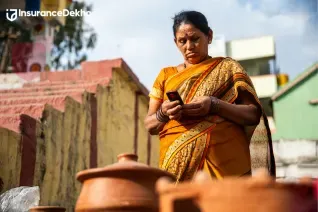Best LIC Policy For A Girl Child In India
As a parent, everyone wishes to empower their little girls to achieve everything they set their mind to. But let’s face it: life can be unpredictable, and educational expenses, weddings, and extra expenses can pile up at any time. This is where life insurance policies from LIC for girl childs come in, offering their helping hand to secure your girl child’s future. It helps them to determine their smooth journey towards their financial freedom.
In this article, we have carefully curated the top LIC policies for your daughter’s future by looking into the policy’s features, benefits, and returns.
Best LIC Policies for Girl Child
In India, parents have the flexibility of choosing the best LIC policy that aligns with their daughter's prospects, preferences, and vision for their future. LIC policies in India offer a wide range of schemes that families can customise as per their needs and choices. Here are some of the most premium LIC policies in India, which are categorically designed to help a girl child:
1. LIC Jeevan Tarun
The LIC Jeevan Tarun policy is created specifically to satisfy the parent’s desire and growing needs of their daughter. This plan starts with the educational requirements and continues to include all of her additional needs. Eventually, leading to her fulfilling all her dreams while she is growing up.
Eligibility:
The eligibility requirements are mentioned below:
|
Parameters |
Minimum |
Maximum |
|
Entry Age |
90 days |
12 years |
|
Maturity Age |
25 years |
|
|
Sum Assured |
Rs. 75000 |
No limit |
|
Policy Term |
(25 - entry age) years |
|
|
Premium Paying Term |
8 years |
(20 years - entry age) years |
Benefits:
-
Exclusive premium waiver option
-
Flexibility option to choose a Survival Benefit Contribution period ranging from 20 to 24 years, depending on the requirements.
-
In cases of a parent's untimely death, the policy's unique risk coverage gives the child the choice to receive 125% of the total sum assured or 105% of the total premium paid.
-
The policy does not specify a maximum amount. But you should have at least Rs. 75,000 in coverage.
-
According to Section 80 (C) and Section 10 (10D) of the Income Tax Act, 1961, the policy's maturity amount is qualified for tax benefits.
2. LIC Jeevan Labh
From the early age of 8 years, your daughter can start reaping the benefits of LIC Jeevan Labh. With this policy, you also have the option to take out a loan using the policy as collateral and have the flexibility to choose how you receive the maturity amount with this policy.
Eligibility
The eligibility requirements are mentioned below:
|
Parameters |
Minimum |
Maximum |
|
Entry Age |
8 years |
50 years (Policy term of 25 years) 54 years (Policy Term of 21 years) 59 years (Policy Term of 16 years) |
|
Maturity Age |
- |
75 years |
|
Sum Assured |
Rs. 2,00,000 |
No limit |
|
Policy Term |
3 options available - 16 years, 21 years, 25 years |
|
|
Premium Paying Term |
10 years, 15 years, 16 years |
|
Benefits:
-
There is no maximum limit, but the minimum sum assured is Rs. 2,00,000.
-
Rider options, including Premium Waiver, Accidental Benefit, Critical Illness, Term Assurance, and Accidental Death and Disability, are available.
-
If the policyholder passes away, the beneficiary will receive a minimum of 105% of the premiums paid.
3. LIC New Children’s Money Back Plan

With the LIC New Children's Money plan, you can ensure that your child is protected from risks for the entire duration of the policy. Both parents and grandparents can easily access it. When the plan matures, it provides dual benefits where the policyholder receives both a lump sum and a bonus amount. The policyholder can also claim the survival benefit if they live through the term.
Eligibility
|
Parameters |
Minimum |
Maximum |
|
Entry Age of Child |
0 years |
12 years |
|
Maturity Age of Child |
25 years |
|
|
Sum Assured |
Rs. 100000 |
No limit |
|
Policy Term |
(25 years - entry age) years |
|
Benefits:
-
Parents can now enjoy the perks of the policy and save money with the added bonus of receiving a refund on high premiums.
-
When young girls reach the ages of 18, 20, and 22 years, they are provided with a secure survival benefit, which is equivalent to 20% of the basic sum assured,
-
Options to surrender the policy are available after 3 years of the term, only after all the premiums have been paid to that point.
-
The beneficiary will get more than the sum assured in death benefits, up to 105% of the total premium paid.
-
Monthly premium payments are allowed a 15-day grace period.
4. LIC SIIP
This plan operates on a unit-linked basis and is a non-participating individual life insurance plan. This means that a part of your premium is allocated to funds with different levels of risk, while the rest is used for insurance coverage. Your daughter will be able to access the maturity benefit when the policy matures. This amount can be used to support her higher education or fulfil her lifelong aspirations.
Eligibility
|
Parameters |
Minimum |
Maximum |
|
Entry Age of Child |
90 days |
65 years |
|
Maturity Age of Child |
18 years |
85 years |
|
Sum Assured for people below 55 |
10X annualise premium |
|
|
Policy Term |
10 years |
25 years |
|
Premium Paying Term |
10 years |
25 years |
Benefits
-
Guaranteed additions ensure that she can maintain her current lifestyle without any worries.
-
Additionally, the plan offers the choice to add LIC's Linked Accidental Death Benefit Rider, which can provide extra coverage.
-
The partial withdrawal feature offers the flexibility to access funds in case of unexpected financial needs, starting from the 5th year of the policy.
-
The plan provides four different ranges of funds to choose from or switch between based on the level of market risk that suits your needs.
5. LIC Jeevan Umang
Since LIC Umang is a participating, non-linked, and whole-life assurance plan, your daughter will receive the profits earned by the company during the policy term. She will also receive the sum assured on policy maturity, which is called a maturity benefit. The plans offer features such as regular payouts, survival benefits, and maturity benefits. Tax benefits can also be availed on maturity, death, or annual survival benefits. [6]
Eligibility
|
Parameters |
Minimum |
Maximum |
|
Entry Age of Child |
90 days |
55 years |
|
Maturity Age of Child |
100 years |
|
|
Sum Assured |
Rs. 200000 |
No limit |
|
Policy Term |
100 minus entry age |
|
|
Premium Paying Term |
15 years, 20 years, 25 years, 30 years |
|
|
Age at the end of premium paying term |
30 years |
70 years |
Benefits
-
An 8% survival benefit will be paid annually when all the premiums are paid and the policy term is over.
-
Rider options, including LIC's Accident Benefit Rider, LIC's New Term Assurance Rider, LIC's New Critical Illness Benefit Rider, and LIC's Premium Waiver Benefit Rider, are available.
-
Funds from the policy can be accessed through the loan feature, providing an extra safety net for your daughter in unexpected situations.
-
Lifetime coverage up to the age of 100 years.
Benefits for LIC Policies For Your Girl Child
LIC offers a combination of benefits that can be very helpful in deciding the best plan for your child and shaping their future. Following are some of the merits of LIC policies for your girl child:
-
Tuition Fee Cover: Your daughter's future can be protected by Investing in a suitable LIC policy if something unforeseen happens to you or otherwise. A solid and comprehensive policy helps cover your daughter’s educational expenses without jeopardising her academic journey.
-
Support in Higher Education: If you get the correct LIC policy, you can customise it to help fund your daughter's dream of attending one of the many prestigious universities in India or abroad.
-
Managing Marriage Expenses: A good LIC policy for your girl child will cover all her needs, whether it is personal or for higher education. You can get it personalised to get the payout in a lump sum, quarterly, or monthly mode, depending on your needs. You can use these payouts to cover your daughter's wedding expenses.
-
Build Savings: Creating a side income is a goal for everyone in order to increase their savings and financials. However, with changing market dynamics, it is not always feasible. Therefore, investing in LIC plans that include features like Systematic Transfer Plans, Child Plans, and Dynamic Fund Allocation safeguards our investments, limits our losses, and maximises our returns.
-
Tax Benefits: Premiums paid in these policies qualify for tax deductions according to the prevalent Income Tax Act laws. LIC plans are designed to provide dual benefits as it offers investment with tax benefits. This allows you to build a secure future for your daughter while also saving on tax benefits and creating wealth.
-
Additional Perks: Along with attractive tax benefits and investment options, some additional benefits come along with the LIC policy. Features like a Flexibility plan increase the feasibility of a policyholder receiving the lump sum payout at the time of maturity or survival benefits in case of untimely death.
How to choose the right plan
Selecting the right policy for your girl child depends on a lot of factors. Whether it is for her education, marriage, or other life goals, there is an LIC policy available to make those dreams a reality. Let’s look at how these factors can help you choose the right plan:
-
Your Daughter’s Age: The minimum age to enrol in LIC plans varies with plan eligibility. When thinking about the best and most suitable options, keep your daughter's age in mind to make the best choice.
-
Financial goals: Identify your daughter's long-term financial goals according to her dreams and aspirations. Whether you will need it for her education or marriage or are you looking for a plan that provides regular payouts? Choose the right plan that is aligned with such long-term goals.
-
Policy term: LIC plans offer various policy terms. Consider your investment limit and the ability to pay those premiums and choose the term that best suits your needs.
-
Premium payment capacity: Be realistic with your budget and capability to pay the premiums. Choose a plan that has an affordable premium amount for a policy term that you are comfortable with.
-
Riders: Several riders can be added to the existing LIC plans for some added benefits.
Conclusion
LIC policies can become a valuable tool to empower your daughter's future. It covers financial security for her educational dreams and the hefty wedding expenses of her dreams. It is a safety net that gives her all the happiness she deserves by giving her the chance to reach her full potential.
Choosing the right policy and starting early can be a motivating force for her success story. With InsuranceDekho's guidance, you can confidently choose the best policy for your daughter’s bright future.




























































